

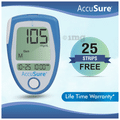
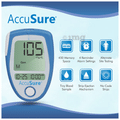
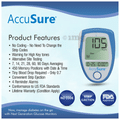
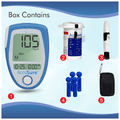

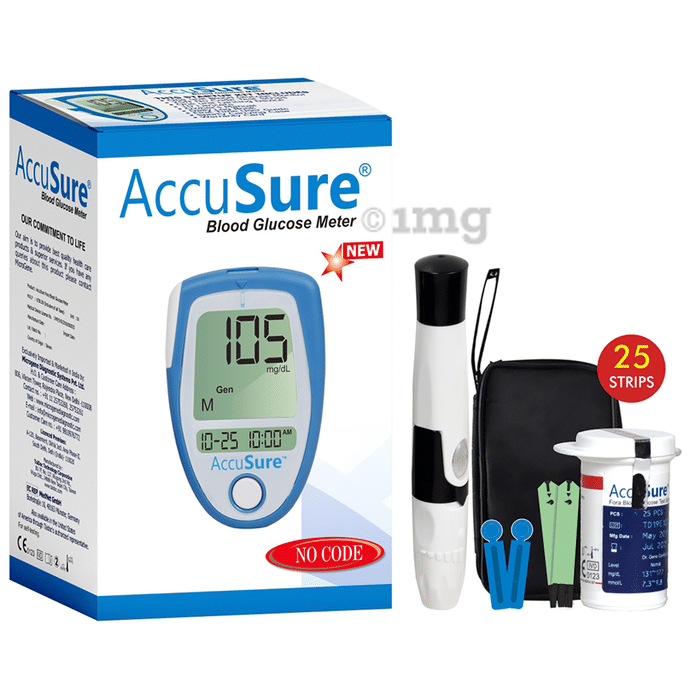
AccuSure Blood Glucose Meter Glucometer with 25 Test Strip
Product highlights
- 0.7 μL blood volume needed
- Memorises up to 450 rest results with date and time
- No coding technology
- Strip ejection mechanism
- AST (alternate site testing)
- Ketone (high) warning
MRP₹622.88Discount Percentage: 12% off
₹Discounted Price: 550
Inclusive of all taxes
of1 Unit
- New GST benefit included in this MRP, may differ from label
- Not returnable Read policy
SOLD OUT
Information about AccuSure Blood Glucose Meter Glucometer with 25 Test Strip
AccuSure Blood Glucose Meter Glucometer with 25 Test Strip
AccuSure Blood Glucose Meter with 25 Test Strip has 450 memory space and four reminder alarm settings. The strip codes do not need to change; just a tiny drop of blood (0.7) is required. It comes with a lifetime warranty and is an easy-to-use device that helps monitor blood glucose levels.
Uses:
A glucometer is used to monitor blood glucose levels.
Product Specifications And Features:
Safety Information:
Quick Tips:
["For in-vitro diagnostic use only", "Do not take any medical decisions without consulting a doctor", "Always discuss the results with a registered medical practitioner", "Do wash the hands thoroughly with an antiseptic hand wash before the test", "Do not squeeze your finger when taking a blood drop sample"]
Warranty Info:
Lifetime warranty (condition apply)
Faqs:
AccuSure Blood Glucose Meter with 25 Test Strip has 450 memory space and four reminder alarm settings. The strip codes do not need to change; just a tiny drop of blood (0.7) is required. It comes with a lifetime warranty and is an easy-to-use device that helps monitor blood glucose levels.
Uses:
A glucometer is used to monitor blood glucose levels.
Product Specifications And Features:
- Blood volume: 0.7 μL
- Memory capacity: 450 measurements with date and time
- Averaging days: 7, 14, 21, 28, 60 and 90
- Conformance to US FDA standards
- Easy-to-use device that helps monitor blood glucose levels and has four reminder alarm settings
- No coding technology to automatically code to match the test strips, which means no need to change the strip codes and ensure accurate results
- AST (alternate site testing) allows using a blood sample other than the fingertips to obtain blood for blood sugar testing, such as the palm, the upper forearm, the abdomen, the calf and the thigh
- Strip ejection mechanism to minimise the risk of contagion as it helps in disposing of used strips without having to touch them
- Ketone (high) warning when the measurement reaches over 13.3 mmol/L with a smiley indicator
Safety Information:
- Read the label carefully before use
- Store in a cool and dry place, away from sunlight
- Keep out of reach of children
Quick Tips:
["For in-vitro diagnostic use only", "Do not take any medical decisions without consulting a doctor", "Always discuss the results with a registered medical practitioner", "Do wash the hands thoroughly with an antiseptic hand wash before the test", "Do not squeeze your finger when taking a blood drop sample"]
Warranty Info:
Lifetime warranty (condition apply)
Faqs:
- How do blood glucose monitors work? Diabetes devices or glucometers test the amount of glucose in the blood. The test strips in glucometers contain an enzyme glucose oxidase, which reacts with glucose in the blood and sends the result as an electronic signal displayed on the monitor.
- How often should you test your blood glucose levels? Talk to your healthcare provider about how often blood glucose levels should be tested.
Country of origin: Taiwan









